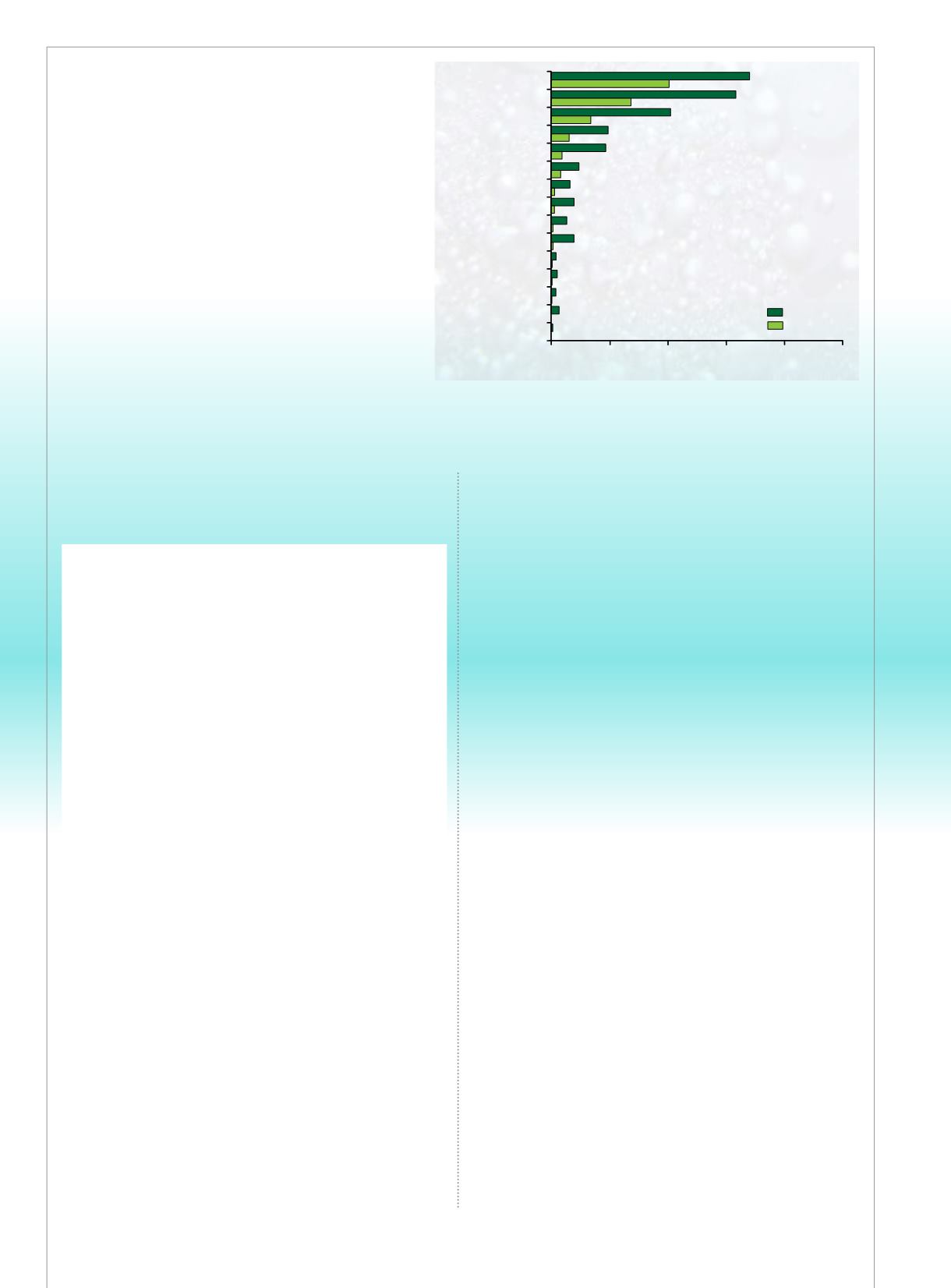
DCS: Bubble Trouble
DCS is associated with the absorption of inert
gas (nitrogen or helium) into tissue coupled
with an ascent to reduced ambient pressure,
where the elimination of the gas may result in
bubble formation. This promotes inflammation
and tissue trauma.
Integral to understanding this disease are the
gas laws of Boyle, Henry and Dalton. Boyle’s
law explains why we must inhale progressively
greater numbers of gas molecules per breath as
we descend for our bodies to maintain pressure
in our chest equal to that of the ambient
environment. The increased number of gas
molecules in our lungs relative to those in our
blood and tissues creates a diffusion gradient,
which, according to Henry’s law, drives the gas
molecules into solution. Which and how many
of these molecules we absorb is defined by Dalton’s law
and is also influenced by differences in blood flow to
different parts of our body.
The longer and deeper we dive, the more gas we
absorb. When sufficient quantities of inert gas come
out of solution and form bubbles during ascent, local
and systemic inflammatory and vascular reactions
may ensue, potentially leading to a broad range of
clinical manifestations. Unlike AGE, DCS bubbles exist
primarily in the venous bloodstream and within tissues,
and symptoms may not appear for several hours.
DCS is linked to an inert gas load (decompression
stress) and the presence of bubbles in the bloodstream.
Although high bubble scores (as evaluated by
ultrasound) are not diagnostic of DCS, they indicate
considerable decompression stress and are more highly
associated with the onset of DCS symptoms than lower
scores. Symptom onset time is roughly correlated with
inert gas load: Higher loads are associated with quicker
onset and more rapid progression of symptoms. A
fascinating aspect of DCS is that symptom onset often
occurs well after bubbles are detectable. Thus, while
bubble detection is an indicator of decompression
stress, it is not a diagnostic criterion.
Current research in DCS is focused on biological
markers that can be detected in the blood. Investigators
are exploring the potential association between
decompression stress and the presence of membrane
microparticles (membrane-bound vesicles shed from a
variety of cell types) in the blood. Microparticle levels
increase in association with many physiological disease
states as well as with the shearing stress caused by
bubbles in the blood. The working hypothesis is that
certain microparticles (possibly induced by inert gas
bubbles) may initiate, be a marker of or contribute to
the inflammatory response that leads to DCS. This
investigation goes beyond the pure bubble model.
Gas Laws Relevant to
Understanding DCI
Boyle’s Law
:
At a constant temperature, the
volume of a given gas is inversely proportional to
the ambient pressure.
To maintain a neutral lung volume as we descend
on scuba, we inhale proportionally more gas
molecules per breath.
Dalton’s Law
:
The total pressure exerted by a
gas mixture is equal to the sum of the partial
pressures of each individual gas in the mixture.
As we breathe more gas molecules per breath on
descent, the potential impact of elevated partial
pressures becomes important. Nitrogen narcosis
results from an elevated partial pressure of
nitrogen.
Henry’s Law
:
At a constant temperature, the
amount of a given gas that dissolves into a liquid
is directly proportional to the partial pressure of
that gas above the liquid. In physiological terms,
this gas pressure exists in our lungs relative to the
gas pressure in our blood.
The greater the pressure of gas in our lungs, the
more gas will dissolve into our blood and tissues.
This is the basis of decompression sickness.
Classification and frequency distribution of initial and eventual manifestations of
decompression illness in 2,346 recreational diving accidents reported to Divers
Alert Network from 1998 to 2004.
0
0.04
0.04
2.8
0.3
1.8
0.3
2.1
0.4
1.8
0.8
1.2
7.9
7.9
1.3
6.5
3.4
3.8
9.5
18.7
6.1
19.4
40.8
27.4
40.6
63.4
68.0
13.6
0.9
5.6
0.4
Pain
Cardiovascular
Bladder, bowel
Lymphatic
Auditory
Consciousness
Coordination
Pulmonary
Mental status
Muscular discomfort
Cutaneous
Muscular weakness
Dizziness/vertigo
Constitutional
Numbness, paresthesia
20
40
60
Occurence (% of patients)
Symptoms
All symptoms
First symptom
80
100
90
|
spring 2014


